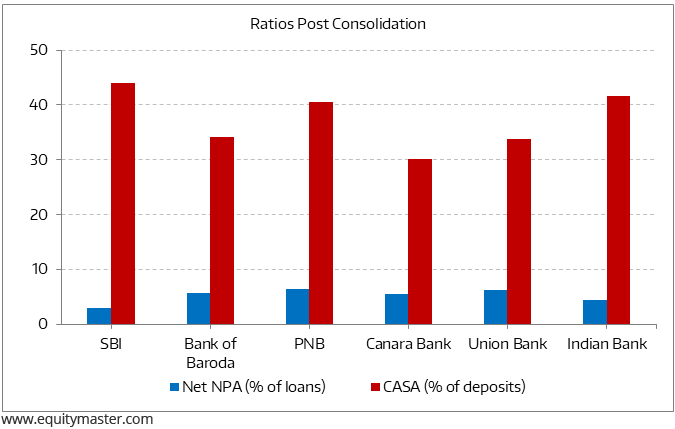- Home
- Todays Market
- Indian Stock Market News March 6, 2020
Sensex Down Over 1,250 Points Tracking Global Sell-Off; Yes Bank Sinks 80% Fri, 6 Mar 12:30 pm
Editor's note: Dear reader, we are now on Telegram! Get our latest views on stock markets and more, instantly. Join our Telegram channel here!
Share markets in India are presently trading deep in the red, tracking a sell-off in global markets as a new wave of fear about the spread of the coronavirus and its economic impact gripped investors.
The BSE Sensex cracked over 1,450 points in opening trade while the NSE Nifty plunged below the 10,900-mark at one go.
Selling pressure was also seen as the Reserve Bank of India (RBI) on Thursday superseded the board of Yes Bank and imposed a 30-day moratorium on it in the absence of a credible revival plan.
All sectoral indices are trading on a negative note with stocks in the banking sector, finance sector and metal sector witnessing most of the selling pressure.
The BSE Sensex is trading down by 1,158 points (down 3%), while the NSE Nifty is trading down by 358 points (down 3.2%).
The BSE Mid Cap index and the BSE Small Cap index are trading down by 3.2% and 2.8%, respectively.
The rupee is trading at Rs 73.64 against the US$.
--- Advertisement ---
Investment in securities market are subject to market risks. Read all the related documents carefully before investing

Details of our SEBI Research Analyst registration are mentioned on our website - www.equitymaster.com
----------------------------------------
In latest developments from the IPO space, the Rs 2.1 billion initial public offer (IPO) by Antony Waste Handling Cell got subscribed by 13% on March 5, day 2 of the bidding process.
The issue saw bids for 6,45,100 shares compared with the issue size of 48,20,508 shares. The price band of the issue is set at Rs 295-Rs 300 per equity share.
The offer includes fresh issue of up to Rs 350 million worth of equity shares and an offer for sale of up to 57,00,000 shares.
The company has already garnered Rs 609.4 million from 3 anchor investors.
The issue will close for subscription today.
Meanwhile, the IPO of SBI Cards and Payment Services managed to attract bids worth Rs 2 trillion, despite challenging market conditions.
The 100-million share offering generated close to 2.7 billion bids. The high net worth individual (HNI) portion of the IPO was subscribed 44 times, while the retail portion was subscribed 2.5 times.
The employee segment registered 4.7 times subscription, while the shareholder category was subscribed 25 times, making it a rare instance in which the employee and shareholder segments garnered higher subscription than the retail segment.
The institutional portion of the IPO garnered 57 times subscription.
Given the huge oversubscription, shares of SBI Cards will be priced at the upper end of the price band of Rs 750-755 per share.
Taking the upper end of the price band, SBI Cards' post-issue market capitalisation would be around Rs 710 billion, making it India's 38th most valuable company.
Through the share sale, the company issued fresh capital worth Rs 5 billion. State Bank of India (SBI) sold its 4% stake, while Carlyle sold 10% in the firm.
SBI Card's total credit card spends grew at a compounded annual growth rate of 54.2% over FY17-FY19 compared with an industry average of 35.6%.
The credit card-to-debit card ratio for SBI Cards stands at 3.7% compared with 45% of HDFC Bank, 28% for Axis Bank and 18% for ICICI Bank.
To know more the SBI Cards' business, the credit card industry, and whether you should apply to this IPO, you can read one of Ankit's latest notes here: SBI Cards IPO: Apply or Avoid? (requires subscription).
Moving on to news from the banking sector, the boards of 10 public sector banks on Thursday approved mergers and issued share-swap ratios to create four large banks in the economy.
The merger will be effective from April 1.
The four anchor banks will be Punjab National Bank (PNB), Canara Bank, Union Bank of India, and Indian Bank.
According to notifications to the stock exchanges, PNB will issue 1,150 shares for 1,000 shares of Oriental Bank of Commerce, and 121 shares for 1,000 shares of United Bank of India.
--- Advertisement ---
Investment in securities market are subject to market risks. Read all the related documents carefully before investing
Choose Your Pick
Unnecessarily Risky Small Caps vs Small Caps Brimming with Opportunity
Discover the Small Cap Strategy Thousands of Equitymaster Subscribers Use
I'm interested
Details of our SEBI Research Analyst registration are mentioned on our website - www.equitymaster.com
---------------------------------------------
Meanwhile, Union Bank of India will issue 325 shares for 1,000 shares of Andhra Bank, and 330 shares for 1,000 shares of Corporation Bank.
Allahabad Bank said for every 1,000 shares of Allahabad Bank, there would be 115 shares of Indian Bank.
Last year, Bank of Baroda took over Vijaya Bank and Dena Bank. Before that, State Bank of India (SBI) had merged all its five associate banks with itself to enter the global top 50 banks' list in terms of size.
The Union Cabinet had approved the consolidation to build the mega banks to create more efficient and bigger public sector banks in the challenging environment to meet the credit needs of a growing economy and to achieve operational efficiency by scale of business.
As per reports, the amalgamation will lead to a wide geographical reach, technology adaption, and, more importantly, better utilization of scarce capital.
Speaking of PSBs, which banks look the best match post the latest matchmaking of PSU banks?
Needless to say, most investors would also be worried about the level of NPAs and current and savings accounts (CASA) of the merged entities.
Lower NPA ratio and sustenance of high CASA, in the future, could signal the banks' fitness levels to lend more.
But what could go unnoticed is the efficiency potential of the merged entities.
Post-merger, the employee per branch ratio of the consolidated PSU entities could be in the range of 7 to 9 per branch. This would be almost half that of their private sector counterparts like HDFC Bank and Kotak Bank.
India's Top 6 Public Sector Banks Are Getting Fitter
Leaner operations would mean use of technology to support growth.
So, we would not be surprised if the PSU entities leverage technology at a much bigger scale than their private sector peers, in a few years.
To know what's moving the Indian stock markets today, check out the most recent share market updates here.
For information on how to pick stocks that have the potential to deliver big returns, download our special report now!
Read the latest Market Commentary



Equitymaster requests your view! Post a comment on "Sensex Down Over 1,250 Points Tracking Global Sell-Off; Yes Bank Sinks 80%". Click here!
Comments are moderated by Equitymaster, in accordance with the Terms of Use, and may not appear
on this article until they have been reviewed and deemed appropriate for posting.
In the meantime, you may want to share this article with your friends!